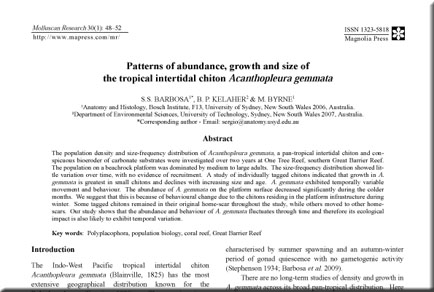Abstract
The population density and size-frequency distribution of Acanthopleura gemmata, a pan-tropical intertidal chiton and conspicuous bioeroder of carbonate substrates were investigated over two years at One Tree Reef, southern Great Barrier Reef. The population on a beachrock platform was dominated by medium to large adults. The size-frequency distribution showed little variation over time, with no evidence of recruitment. A study of individually tagged chitons indicated that growth in A. gemmata is greatest in small chitons and declines with increasing size and age. A. gemmata exhibited temporally variable movement and behaviour. The abundance of A. gemmata on the platform surface decreased significantly during the colder months. We suggest that this is because of behavioural change due to the chitons residing in the platform infrastructure during winter. Some tagged chitons remained in their original home-scar throughout the study, while others moved to other homescars. Our study shows that the abundance and behaviour of A. gemmata fluctuates through time and therefore its ecological impact is also likely to exhibit temporal variation.

